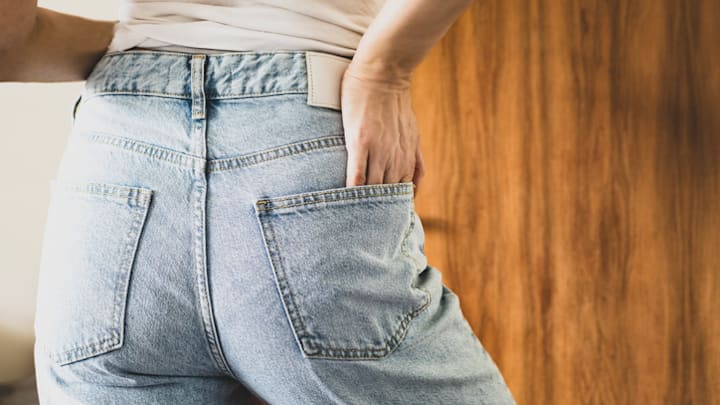You can thank your butt for a number of physical actions you take every day: moving your hip and thigh during walking or running, rising from a sitting position, climbing, and even just standing upright. While lack of exercise can make these muscles soft, in general they’re some of the hardest working muscles in your body. In 2017, Mental Floss spoke with Clifford Stark, a professor at NYU Langone Medical Center, and Vivian Eisenstadt, an orthopedic and spine specialist in physical therapy in Los Angeles, to learn more about this fundamental body part. Here are six quick facts we picked up.
- The butt is the body’s most powerful muscle group.
- Back pain may originate in your buttocks.
- Sciatica can start there, too.
- Butt-related plastic surgery is very popular.
- Mooning has been around since the 1960s.
- Victorians were really into erotic spanking.
The butt is the body’s most powerful muscle group.
Your glutes are your body's largest and strongest muscle group, Stark told Mental Floss. Your buttocks are actually comprised of three gluteal muscles: the gluteus maximus, gluteus medius, and gluteus minimus, often shorthanded to “the glutes.”
“They are extremely important in preventing all sorts of injuries” to knees and hips, Stark adds. It's best to keep your glutes strong but not tight.
Back pain may originate in your buttocks.
“A little-known fact is that strengthening your buttocks helps decrease back pain,” Eisenstadt told Mental Floss. “While physical and occupational therapists know this, many people are not aware and increase risk of injury by neglecting this important muscle.” In her practice, when people come in complaining of back pain, she checks out their butts first.
Sciatica can start there, too.
“Sciatica is a laymen's term for pain down the leg,” Stark said. The sciatic nerve typically lies right on top of the piriformis, a small muscle that lives deep in the buttock, behind the gluteus maximus. For a certain percentage of the population, however, the sciatic nerve sometimes pierces right through the muscle. Those people are especially prone to sciatic pain, Stark said: “All it takes is a spasm to cut off that nerve.”
Butt-related plastic surgery is very popular.

In 2023, surgeons affiliated with the American Society of Plastic Surgeons performed 29,383 Brazilian butt lifts (buttock augmentation with fat grafting), 1234 butt implants, and 7748 butt lifts, all of which represented slight upticks from the previous year {PDF}. Yet, while butt surgery may be increasingly popular, it still hasn't cracked the top five most commonly performed cosmetic surgical procedures (which are liposuction, breast augmentation, tummy tuck, breast lift, and eyelid surgery, in that order {PDF}).
Mooning has been around since the 1960s.
Human butts have been likened to the moon for a long time. During China’s Ming Dynasty (1368-1644 CE) bare buttocks were seen as quite erotic and often compared to a full moon, perhaps because of their pert roundness. Much later on, mooning emerged as a pop culture fad in the 1960s, mostly among college students. The Oxford English Dictionary cites a 1964 Princeton Alumni Weekly article coining the usage; an evidently losing baseball team lamented that “all we had was ... abortive efforts at mooning the Yale team in their dugout.”
Victorians were really into erotic spanking.
While spanking is bad for kids, it was good for some Victorians, who were rather fond of flagellation (getting spanked or whipped for sexual pleasure). Deborah Lutz, author of Pleasure Bound: Victorian Sex Rebels and the New Eroticism, told Salon that “something like 50 percent of the pornography of the time was flagellation pornography.” One prevailing theory behind its popularity is that the practice stemmed from the experiences of upper-class British men who had attended private schools, where a common punishment was to be ordered to drop their trousers and be flogged with birch switches in front of their classmates. “Any schoolboys who wanted to could come and watch. For many of these boys, of course, it was traumatic, but for other boys it’s an erotic experience. It developed into this masochistic eroticism,” Lutz said.
Learn More Fascinating Facts About the Human Body:
A version of this story was published in 2017; it has been updated for 2025.
